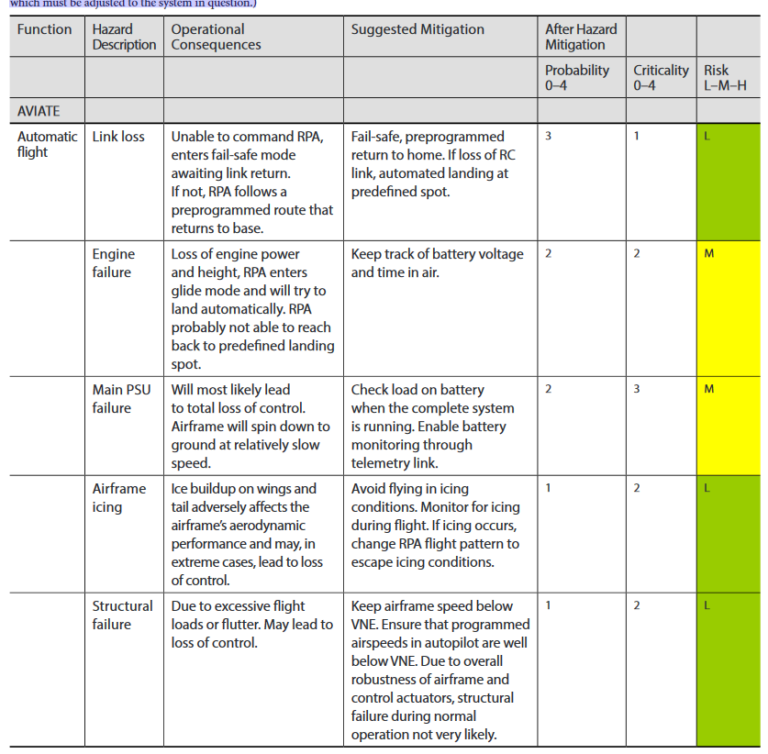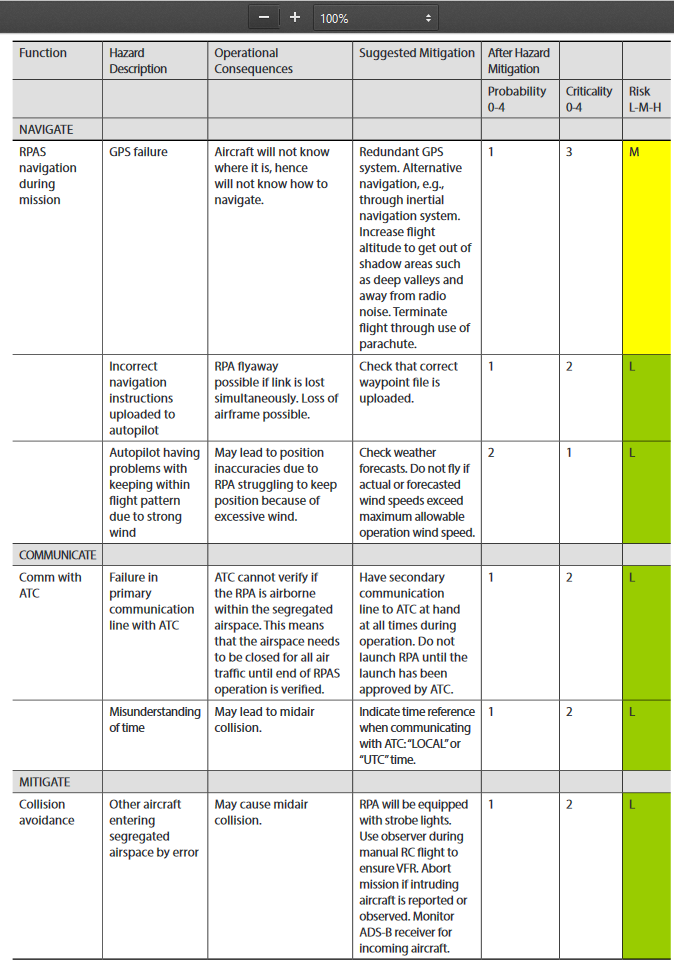Continuation of Risk Assessment and Management
RPA DETECTION OF HAZARDS
RPA may detect hazards, including conflicting traffic, using optical and non-optical technologies. Detection may be supported by the use of a database (e.g. terrain and obstacles).
Optical techniques: Optical techniques are based on visible and near-visible (ultraviolet and infrared) EM radiation. Examples include video, light detection and ranging (LIDAR) and thermal imaging.
Non-optical techniques: Non-optical techniques are based mainly on radio-frequency electro-magnetic (including microwave) radiation. Examples include primary radar, SSR, ADS-B and multi-lateration. Non-optical techniques are generally not dependent on meteorological conditions.
Hazardous meteorological conditions
UAV operations should not commence or be aborted if :
- high wind or wind gusts in excess of UAV manufacturers recommendations
- fog and smoke
- rain
- hail
- snow
- thunder/lightening
- other airborne hazards, including wake turbulence, wind shear, birds or volcanic ash.
One or more detect and avoid (DAA) capabilities may be needed to meet requirements to address the hazards listed above unless the RPA exposure to these hazards and risk to persons, property or other aircraft can be reduced to an acceptable level through restrictions to the RPA operating environment, flight timing or flight profile. For example, if an RPA will only be operated in fair meteorological conditions, then the capability to detect and help the pilot avoid hazardous meteorological conditions may not be required. However, if an RPA cannot be prevented from encountering these hazards, then systems and procedures may be needed to provide appropriate DAA capabilities for each hazard.
Safety analyses may be needed to establish RPAS capabilities to mitigate the consequences of each specific hazard that may be encountered
Risk identification
Risk Assessment
A risk assessment must be carried out to quantify the actual threat posed by the RPAS operations. One example of an analysis is based on the approach described by Weibel and Hansman of the Massachusetts Institute of Technology (MIT), with some adaptation to the RPAS in consideration. The analysis covers the two major concerns in RPAS operation with respect to public safety, namely ground impact and mid-air collision with manned aircraft. For these two main scenarios, calculation models are established to calculate overall risk as the product of incident frequency and consequence with respect to human life. The risk analysis is based on the assumption that necessary mitigation of unacceptable hazards is effectively carried out before the start of operations.
Ground impact risk analysis
This analysis is focused on estimating the risk level of RPAS operations related to loss or crash of the RPA. It is not focused on the technical causes of the incidents. Essential input is
- The expected consequences in terms of loss of human life or damage to property and
- The associated probabilities of such loss/crash incidents.
No attempt is made to calculate loss/crash frequencies based on a fault tree analysis of the RPAS and the operation.
The analysis is made in line with the methods described by Weibel and Hansman but is extended somewhat to take into account the fact that a certain percentage of people will be outdoors without any shelter or other protection. Furthermore, a parameter “probability of kill at impact” has been introduced to represent the energy/force level of possible impact with a human. For medium-sized RPAs, the level of injury/fatality may depend on which part of the human body (e.g., eye, head, leg) is hit by the RPA. For large RPAs, this may be of lesser importance, as persons located inside the RPA ground impact area may be assumed killed with 100% likelihood. For a slow EPO (expanded polyolefin) foam micro-RPAS of approximately 3 kg with a pusher, a direct hit has the potential for causing grave injury or death, but the likelihood is small—probably less than 10%.


Identified hazards and mitigations related to navigation, communication, and mitigation activities. Risk level is given as low (L), medium (M), or high (H). (This is an example, which must be adjusted to the system in question.)
Risk mitigation measures
Elements of a job safety assessment (JSA) for the operation of an RPA;
Risk assessment is an essential part of the risk management strategy and is used to determine what risks will be tolerated, mitigated (controlled), or in some cases, avoided. What follows in this section, as well as in Risk Assessment – Risk Analysis, Risk Assessment – Risk Evaluation, Risk Treatment, Monitor and Review represents elements of a potential risk management process that you may wish to implement in your operations. No warranty is given that this will be absolutely suitable for your organisations, and you would need to amend this according to the environment in which your organisation operates.
The process is initiated when:
- an assumption made about risk in the Job Safety Assessment (JSA) is no longer valid,
- the JSA identifies a new risk, or;
- a new operation is undertaken which requires a permission, approval or exemption from CASA or other State or Federal authorities.
The figure below details the safety risk management process that includes the following key areas:
- communication and consultation
- establishing the context
- risk assessment
- risk treatment
- monitoring and review.
Communication and Consultation:
Where possible, any person affected by a risk should be identified and consulted with at each stage of the risk management process. The consultation process requires the sharing of information and should provide the genuine opportunity for all people affected by the risk to be part of the decision -making process.
Clear, open and transparent consultation is a key element in successful risk management practices.
Establishing the context:
In addition to communication and consultation, the context of a risk should be established in terms of its compliance with legislative standards and operational/organisational environment. The following steps should be undertaken to establish the context:
- Topic Objectives – Clearly articulate the specific objectives of the RPAS activity that will be undertaken, including locations, proposed time of operations, etc.
- External Environment – identify and consider what additional matters may need to be considered. This may include the identity of key stakeholders, legal/regulatory requirements from other State or Federal authorities, technical matters relevant to the risk, other activities or sensitivities that may impact on the risk, etc.
- Internal Environment – identify and consider if there are any special internal requirements that need to be considered, including staff training, human factors, reliability and suitability of equipment etc.
- Stakeholders – all stakeholders that may be impacted on the risk need to be identified. This may include the client, other airspace users, members of the public, public interest groups, owners and occupiers of buildings, and Local, State or Federal authorities etc.
Share this

Reach your personal and professional goals
Unlock access to hundreds of expert online courses and degrees from top universities and educators to gain accredited qualifications and professional CV-building certificates.
Join over 18 million learners to launch, switch or build upon your career, all at your own pace, across a wide range of topic areas.
Register to receive updates
-
Create an account to receive our newsletter, course recommendations and promotions.
Register for free








